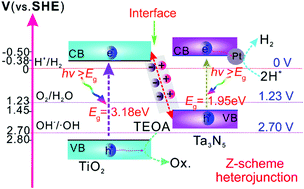Efficient solar photocatalytic hydrogen production using direct Z-scheme heterojunctions†
Abstract
We report the preparation of a series of heterojunctions made of Ta3N5 and TiO2 nanoparticles that show good properties for photocatalytic hydrogen production. The composite photocatalyst with a light-response range up to 620 nm shows a hydrogen evolution rate of 250 μmol h−1. The apparent quantum efficiency at 330 nm can be as high as 46%. Particularly, normalized spectral studies indicate that the heterojunction is more active upon full-spectrum (without using optical filters) irradiation, and its activity is even superior to the total activity exhibited upon UV-light irradiation (λ ≤ 420 nm) and visible-infrared light irradiation (λ ≥ 420 nm). Moreover, in situ photodeposition of platinum nanoparticles on the surface of the photocatalyst as well as the band alignment analysis demonstrate the Z-scheme mechanism associated with the photocatalytic process. Specifically, photogenerated electrons from TiO2 will rapidly combine with the photogenerated holes from Ta3N5 through interfacial charge transfer, leaving the more active electrons and holes in Ta3N5 and TiO2, respectively, to facilitate redox reactions. Basically, TiO2 is only UV-light active, while Ta3N5 can be activated under visible-light irradiation. In this case, a synergy effect, upon simultaneous UV-light excitation and visible-light excitation, can be achieved by full-spectrum irradiation, leading to a much higher photocatalytic activity. This work thus provides a favorable and upward direction for the establishment of heterojunctions for high-efficiency hydrogen production and solar energy applications.



 Please wait while we load your content...
Please wait while we load your content...